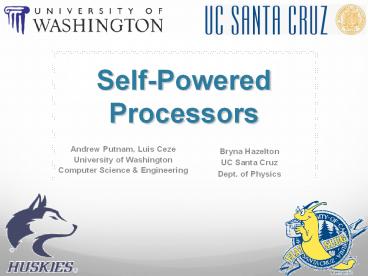Self-Powered Processors - PowerPoint PPT Presentation
Title:
Self-Powered Processors
Description:
SelfPowered Processors – PowerPoint PPT presentation
Number of Views:220
Avg rating:3.0/5.0
Title: Self-Powered Processors
1
Self-Powered Processors
- Andrew Putnam, Luis Ceze
- University of Washington
- Computer Science Engineering
Bryna Hazelton UC Santa Cruz Dept. of Physics
2
What if processors powered themselves?
- No need to cluster around electrical outlets at
conferences
AS PL OS
- Use all of those power pins for something useful
- Run all the speculative and helper threads you
want
- Stop worrying about power management
3
How would this change
- Computing in the 3rd World?
- Remote sensing and data collection?
- Cost and management of data centers, cloud
computing? - Nano-scale machines?
Im graduating offer me a job and get your
company logo here!
4
On-Chip Power Generation
- Chip-Scale nuclear reactors
- Fission
- Alpha decay
- Use heat energy from the environment
- Silicon Solid-state Wiggler
5
Chip-Scale Nuclear Power
- Glow-in the Dark Processors
6
Chip-Scale Nuclear Reactor
- Radioactive isotopes have incredible energy
densities - Uranium-235
- 11.4g (0.60 cm3) provides 50W for 10 years
7
Stirling Engine
- Hot chamber absorbs heat energy from surroundings
- Air flows from hot chamber to cold
- Cold chamber cools, compresses air
- Efficiency has recently jumped from 5 to 38
8
Fission Generator
- Thermally isolated by 5mm Aerogel
- Lithium-6 bath converts neutrons to gamma rays
- 50W continuous power
3cm
CPU
9
Alpha Decay Generator
- Heat from radioactive alpha decay from larger
decay chamber - Alpha decay is easilyshielded
9cm
- Polonium-208, 210
- 53W for 5 years
- Plutonium-238
- 55W for 100 years
- Strontium-90
- 35 W for 40 years
- Requires 1cm lead shielding to block gamma rays
CPU
10
Silicon Wiggle Generator
- Shake it like a Poloroid Picture
11
Spring Capacitor Circuit
12
Spring Capacitor Circuit
- Charge builds up on capacitor plates
13
Spring Capacitor Circuit
- Charge builds up on capacitor plates
- As charge builds, plates are attracted to each
other
Attraction
14
Spring Capacitor Circuit
- Charge builds up on capacitor plates
- As charge builds, plates are attracted to each
other - As plates get closer, attractive force grows
Attraction
15
Spring Capacitor Circuit
- Charge builds up on capacitor plates
- As charge builds, plates are attracted to each
other - As plates get closer, attractive force grows
- Plates contact, and charges move across the plates
16
Spring Capacitor Circuit
- Charge builds up on capacitor plates
- As charge builds, plates are attracted to each
other - As plates get closer, attractive force grows
- Plates contact, and charges move across the
plates - Spring recoils, disconnecting capacitor plates
Recoil
17
Spring Capacitor Circuit
- Charge builds up on capacitor plates
- As charge builds, plates are attracted to each
other - As plates get closer, attractive force grows
- Plates contact, and charges move across the
plates - Spring recoils, disconnecting capacitor plates
- Charges regenerate
18
Spring Capacitor Circuit
- Charge builds up on capacitor plates
- As charge builds, plates are attracted to each
other - As plates get closer, attractive force grows
- Plates contact, and charges move across the
plates - Spring recoils, disconnecting capacitor plates
- Charges regenerate
- Cycle begins again
Attraction
19
n-doped Hammer
p-doped Anvil
20
0.6V
21
Charge
n-doped Hammer
p-doped Anvil
22
Attraction
23
Discharge
24
Recoil
25
Energy Generation
- Charge carriers are thermally regenerated
- Phonon lattice vibration (a.k.a. heat) kicks
electrons to higher-energy state - So the energy comes from the ambient heat around
the device (heat bath) - Device will operate until freezeout temperature
- -173C for Silicon
26
Details
- Piezoelectric converts motion to electricity
- Very high conversion efficiency (50-90)
- Each device 5 nW
- 1 mm3 2.5 W (mobile processor)
- 40 mm3 100 W (high-performance processor)
- 1 m3 2.5 GW (medium-sized city)
- - requires 100C of heat energy per second
- 1 ft3 3.7C / second air conditioner _at_ 46 MW
- Solar cells 4.8 GW / m3 (170 W/m2 0.35 mm
thick)
27
Powering Nano-Devices
2200 µm
6100µm
10 µm
MEMS / NEMS Device
28
Powering Nano-Devices
29
Thank You
- Questions?
30
(No Transcript)
31
2nd Law of Thermodynamics
- "Every physicist knows what the first and second
laws mean, but it is my experience that no two
physicists agree on them." -- Clifford Truesdell
- 2nd law is a statistical law based on classical
mechanics - The applicability of the 2nd Law to quantum
mechanical domains is hotly debated - This isnt a perpetual motion machine it will
stop working with the heat death of the universe
32
Energy Density
- Solar cells 170 W / m2
- 0.35 mm thick
- Power density 4.8 GW / m3
33
(No Transcript)
34
(No Transcript)
35
(No Transcript)
36
(No Transcript)
37
Stirling Engine
- Hot chamber absorbs heat energy from surroundings
- Air flows from hot chamber to cold
- Cold chamber cools, compresses air
38
n-doped Hammer
p-doped Anvil































